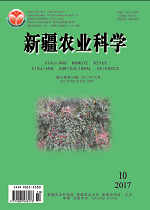|
|
Monitoring and Analysis of Virulence of Blumeria graminis f. sp. tritici in Xinjiang
WANG Zhen-hua, LIU Wei, GAO Hai-feng, FAN Jie-ru, ZHOU Yi-lin
2017, 54(10):
1903-1910.
DOI: 10.6048/j.issn.1001-4330.2017.10.016
【Objective】 Through the virulence identification of Blumeria graminis f. sp. tritici (Bgt) from Xinjiang, the information of structure and composition might provide us with basis for breeding and application of wheat powdery mildew resistance varieties and reasonable deployment of the resistance genes.【Method】Samples of B. graminis f.sp. tritici collected from Xinjiang wheat production area were isolated and purified. Virulence of pathogen isolates was identified and inoculation of wheat with 35 known resistance genes was carried out by shake grafting method to investigate the response pattern of host to pathogen, and to determine the virulence of different strains.【Result】Virulence frequencies of Bgt isolates were less than 30% to Pm1c, Pm2, Pm4a, Pm4b, Pm4c, Pm5b, Pm12, Pm13, Pm16, Pm21, Pm24, Pm25, Pm30, Pm35, PmXBD, Pm2+Mld, Pm2+6, Pm4+8, Pm4b+5b and Pm5+6. None of isolates was compatible to Pm12, Pm16 and Pm21. Virulence frequencies of Bgt isolates ranged from 30% to 70% to Pm3b, Pm3d and Pm34. Virulence frequencies of Bgt isolates was more than 70% to Pm1a, Pm3a, Pm3c, Pm3e, Pm3f, Pm5a, Pm6, Pm7, Pm8, Pm17, Pm19 and Pm1+2+9.【Conclusion】These results suggested resistant genes Pm1c, Pm2, Pm4a, Pm4b, Pm4c, Pm5b, Pm12, Pm13, Pm16, Pm21, Pm24, Pm25, Pm30, Pm35, PmXBD, Pm2+Mld, Pm2+6, Pm4+8, Pm4b+5b and Pm5+6 were effective, especially Pm12, Pm16 and Pm21. Pm1a, Pm3a, Pm3c, Pm3e, Pm3f, Pm5a, Pm6, Pm7, Pm8, Pm17, Pm19 and Pm1+2+9 were not effective and not suitable in wheat breeding and production utilization. Pm3b, Pm3d and Pm34 need rational deployment in wheat production.
|

